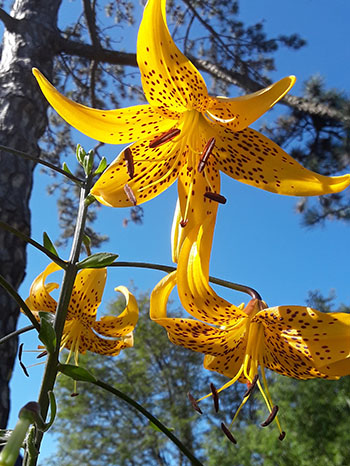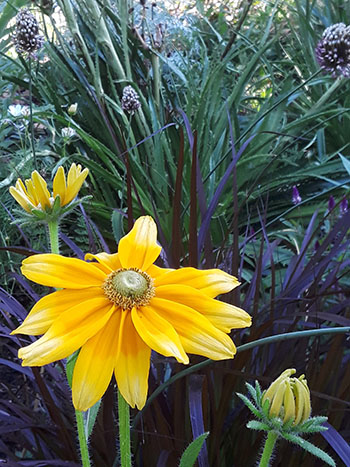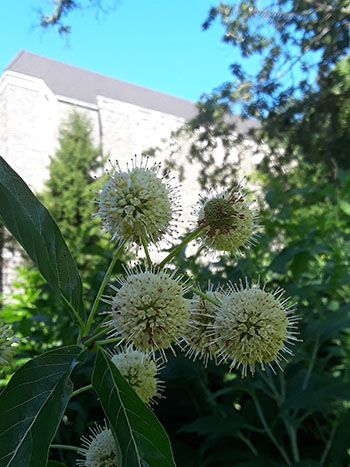
Plant of the Week: July 13

Between the Arboretum offices, the Cunningham House, and Wister Center, a most unique and elegant lily, Lilium leichtlinii (Leichtlin’s lily) has burst into bloom livening up the scene in the bed that surrounds our stately Pinus nigra. L. leichtlinii boasts long, dark, and slender stalks, buds dark purple at the base fading to yellow at the tip, and pendant bright yellow flowers exhibiting unique purplish-red markings. Both the buds and flowers provide exceptional visual interest, complimenting one another nicely. The architecture of the stalk and flowers are utterly captivating to my eye.
These lovely Asiatic lilies grow from bulbs and are quite similar in appearance to the better known tiger lily, Lilium lancifolium, but is just as worthy of a home in the garden. A variety of L. leichtlinii, L. leichtlinii var. maximowiczii, look especially similar to L. lancifolium, and is found widely throughout Japan, Korea, and China, whereas the straight species with yellow blooms is concentrated to central Honshu, the main island of Japan. This has led to speculation that the currently recognized L. leichtlinii species may actually be the variety, with the orange flowered plant, L. leichtlinii var. maximowiczii, being the true species. Taxonomic classification aside, I love and recommend both flower types, as I’m an admirer of both orange and yellow flowers.
Use this plant in a border for color and contrast and plant en masse for the best effect. Avoid poorly drained soils, dry soils and shaded areas. In a natural setting this plant prefers moist soil and grows in meadows with good sun; it has moderate drought resistance as well, making it an appropriate choice for most sunny borders.

Another yellow flowering plant that brings a cheery mood to the sun garden is Rudbeckia hirta ‘Prairie Sun’. Like all black-eyed Susan plants, the petals of this sunflower relative are bright yellow and the flowers have a daisy-like structure. However, in contrast to the typical R. hirta, this variety offers a greenish-yellow center, so it is more of a “yellow-eyed Susan.”
Blooming through most of the summer into the fall, this plant really pulls its weight in the garden. Flowers bloom singly atop stiff, upright stems, and are great for cutting. Stems are sometimes branched, offering more blooms, and with deadheading you can keep the flowers coming at an incredible rate. The unfurling flower is a treat to the eye too and I find excitement in the anticipation of the new blooms. R. hirta grows widely throughout the Central U.S., occurring in prairies, meadows and along roadsides. Blooming in the first year of growth, this biennial/short lived perennial is often treated as an annual by gardeners. Water needs are average and this plant will readily self-sow; plants are also very easy to grow from seed at home prior to the arrival of warm weather. It is a great choice for a variety of garden spaces, including the annual border, cottage garden style, cutting garden, or meadow. R. hirta can tolerate high heat and drought as well as being intolerant of wet, poorly drained soils. Simply provide a sunny spot in well-drained soil, sit back, and enjoy the show! You can find R. hirta ‘Prairie Sun’ dotted throughout the Cut-flower Garden adjacent to the Wister Center greenhouses.

Another unique flower can be found in bloom presently atop the branches of Cephalanthus occidentalis, our native buttonbush. While this shrub is lacking in ornamental appeal throughout much of the summer, the fascinating flower structures that appear in late June into July are sure to draw attention, with an inflorescence that looks like it came from outer space. The minute tubular flowers of C. occidentalis are arranged in a spherical shape atop an erect peduncle, giving a pin cushion appearance. This fun visual treat persists past the flowering period, as the spent flower’s structure remains, providing some interest in the fall and winter. The coarse, lightly exfoliating bark of C. occidentalis can also be quite attractive at times, especially on older specimens. Plants take on a loose, rounded form, growing approximately as wide as tall, usually about 6’ at maturity and up to 15’.
C. occidentalis grows widely throughout North America, always being found in moist areas in a wild setting, though it is tolerant of a wide range of soils types, excluding dry conditions. occidentalis is happy in both sun and part-shade. This wet-loving shrub is rather informal in appearance and looks best when used in a garden with a natural aesthetic. Plant this shrub along water edges, in rain gardens, thickets, woodland gardens, or at the back of a garden border where it can blend in when not in flower.
This shrub is also great for wildlife, quite popular among waterfowl and other birds using it for protection and food. Insects and hummingbirds frequent C. occidentalis as well, and it is noted as a butterfly magnet. You can find C. occidentalis growing in the Biostream, happily tucked along the streambank in an ideal part-shade scenario. Plan a trip to the Scott Arboretum today and you can revel in these flowering beauties, the visiting wildlife, and take some inspiration for your own home garden! (All images by R. Payne-Meyer)





Wendy Coolen
Posted at 06:58h, 24 JulyLove your blog, we have buttonbush and prairie sun growing in our gardens, love them both.